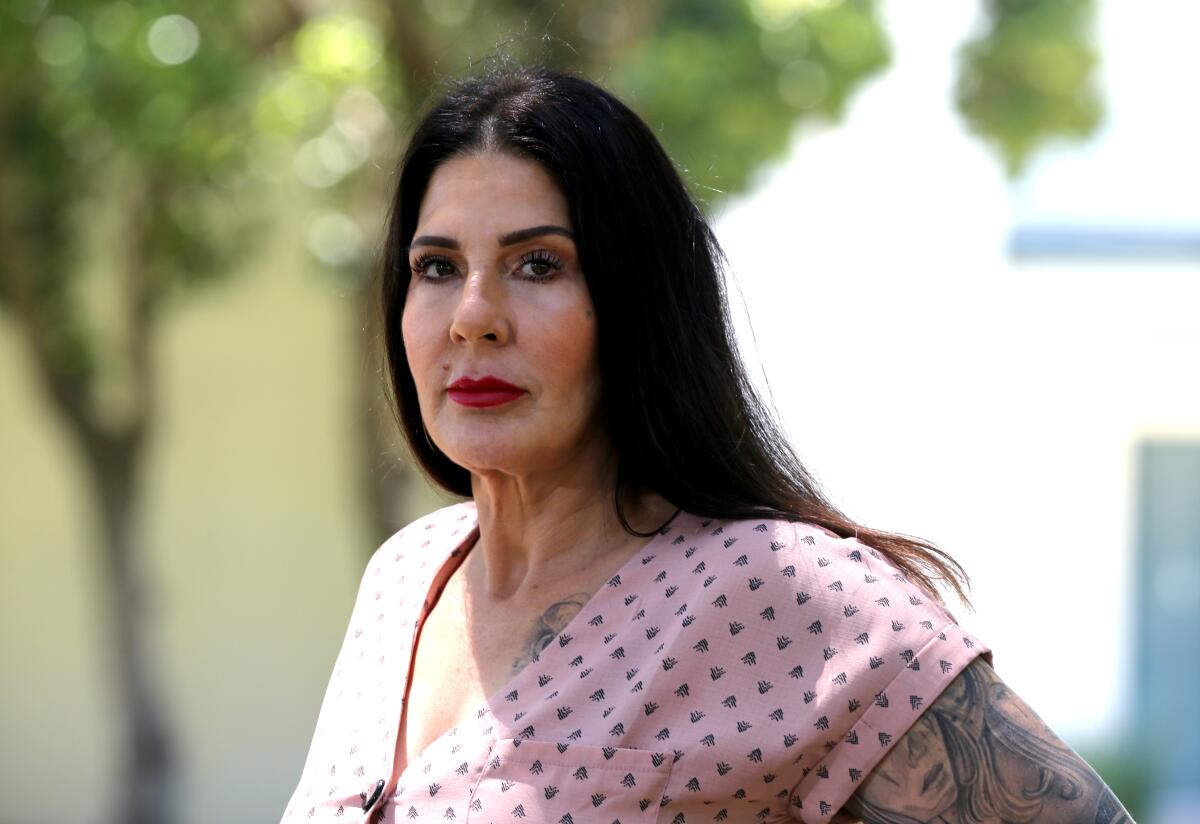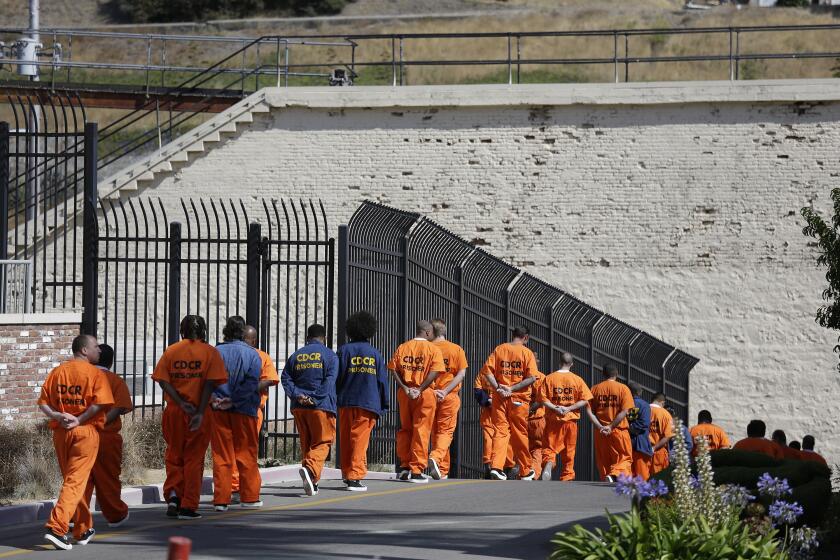‘We just keep punishing.’ Californians with criminal records still face housing barriers

- Share via
SACRAMENTO — Cynthia Blake lives cramped in a tiny studio apartment in Long Beach, in a space divided into four units that used to be a church. There is no bathroom inside her home; it’s outside in a different part of the building.
Blake, 53, remembers the $1,050 apartment being advertised for a long time, as interest in the odd setup was low. Still, she felt she had to lie to be considered a potential renter: she did not check the box that asked if she had ever been convicted of a crime.
If she had, there’s a good chance her application for the apartment would have been denied and her time living on the streets prolonged — a part of her life that she said made her two-year stint in prison for felony drug charges feel like “a relief.”
Housing options for Blake are limited. Tenants are often at the mercy of private landlords who conduct criminal background checks. Regulations restrict people from accessing federally subsidized housing if they’ve been convicted of certain crimes, including drug and sex offenses.
As Gov. Gavin Newsom has pushed criminal justice reform — vowing to close prisons, signing laws to shorten some sentences and calling for the abolishment of death row — housing for those with criminal records often remains out of reach, compounding the state’s homelessness crisis.
Gov. Gavin Newsom has acted on bills aimed at reducing prison sentences for people convicted of drug- and gang-related crimes, despite concerns from prosecutors that the measures will hinder efforts to protect Californians.
The U.S. Department of Housing and Urban Development announced plans this year to reduce barriers to housing for people with criminal records, and similar efforts are underway in California.
A 2020 law banned landlords from discriminating against tenants who use a housing voucher to pay their rent, often one of the only options available for people who’ve left incarceration.
But advocates across the state say not nearly enough is being done to stem the flow of formerly incarcerated Californians onto the streets.
Formerly incarcerated people in the United States are nearly 10 times more likely to experience homelessness than the general public, according to a 2018 study by the Prison Policy Initiative, with Black men and women at particular risk. Seventy percent of unsheltered homeless people in California reported a history of incarceration, according to a California Health Policy Strategies analysis published in 2018 using data from Los Angeles, Orange and San Diego counties.
A 2020 Los Angeles Times investigation found that local crime-free housing policies in California disproportionately put Black and Latino residents at risk of eviction and community displacement.
A lot has changed since Blake was released from prison more than a decade ago. She is no longer sleeping in her car, bathing her children in gas station sinks or selling drugs to earn enough cash to afford a night in the seediest motels.
She is clean from methamphetamine, has earned a master’s degree in sociology from Cal State Dominguez Hills and plans to become a college professor.
Nearly 2,000 communities in the U.S. and elsewhere encourage landlords to evict or exclude tenants who have had some interaction with law enforcement.
Several years after moving into her apartment, Blake can finally afford a bigger, better home. Still, she feels frozen, afraid to attempt to move somewhere new. What if her past crimes come up? What if this is as good as it gets?
“In our society, we just keep punishing. I’ve done my time, so why am I still being punished?” Blake said. “You can’t get a job because of the felonies, you can’t get an apartment because of the felonies, and it goes around and around.
“You end up on the streets, and everyone is telling you that you need to be doing something. But there’s no way in hell to get out of it.”
In June, Newsom and lawmakers funneled hundreds of millions of dollars into expanding workforce development and transitional housing and reentry programs to help “prepare incarcerated individuals to successfully reenter their communities following their release from prison,” according to the state budget proposal.
But other attempts to create more permanent and affordable housing opportunities for those leaving incarceration have so far failed.
Legislation introduced last year to reroute money saved from shuttered prisons to new housing and workforce training opportunities for recently incarcerated people failed in a key fiscal committee. The state hasn’t yet saved money from prison closures to finance the program.
This year, Assemblymember Isaac Bryan (D-Los Angeles) introduced Assembly Bill 1816 to allocate $200 million to launch a broader program than what the state currently offers and bolster long-term housing options for formerly incarcerated people at risk of or experiencing homelessness. The program would also help connect tenants to other services such as job training, mental health care and addiction treatment.
The state budget finalized last month didn’t include money for AB 1816, even though California has a record-high surplus of $100 billion-plus. Bryan said he’s still fighting to get the funding.
“This is a population that we can all agree is vulnerable to falling into the streets. And it’s a population who has paid their debt to society,” Bryan said. “So the only alternative is to keep everybody incarcerated forever. And we have tried that before.”
Emily Harris, a policy director at the Ella Baker Center for Human Rights in Oakland, called barriers to housing for the formerly incarcerated “another form of redlining.”
The disproportionate incarceration of people of color has a lasting snowball effect, Harris said, leading to a higher likelihood of unemployment and homelessness.
Closing prisons and easing sentences for low-level offenders is not enough, she said, if there is nowhere for released prisoners to go when they leave.
“As we’re leaning away from a ‘lock them up’ mentality in California, we need to provide more infrastructure that supports them when they’re coming out,” Harris said. “In terms of the budget priorities of the state, we can invest in imprisonment, which is incredibly costly, or we can invest in other forms of community safety like stable housing, which is much cheaper and has much better long-term impacts on people.”
Daniel Yukelson, executive director of the Apartment Assn. of Greater Los Angeles, said landlords take a risk when they rent to tenants with a criminal history, and not everyone is open to the liability.
“People can’t afford to take a chance anymore,” Yukelson said.
Even those who are able to get housing assistance despite their criminal records face discrimination, months-long wait times and other hurdles in California’s competitive and costly rental market.
Daisy Pelayo was 12 when she started using drugs, leading to more and more jail time into her adulthood. She found refuge in Cameo House, a San Francisco long-term transitional housing and alternative sentencing program for homeless and formerly incarcerated women, an organization Pelayo credits with helping her get back on her feet and rekindle a relationship with her children.
While she was at Cameo House, a housing specialist helped Pelayo navigate the bureaucratic hurdles in applying for Section 8, a federally funded program that helps eligible low-income, disabled and elderly tenants pay rent to private landlords. Certain felonies automatically disqualify applicants, such as any crime that requires lifelong registration as a sex offender.
Pelayo, 36, qualified for the financial assistance. Then came the hard part.
“The biggest hurdle I found was that there’s a stigma with people that had Section 8,” Pelayo said. “It was like the second I said ‘Section 8,’ right away, they are looking at you different.”
Rebecca Jackson, Cameo House’s director, said finding housing is one of the biggest challenges for the women at Cameo House. Women can stay up to two years in the program, but it often takes months to be approved for financial assistance, Jackson said. Many women are forced out of their communities in order to find housing.
“I am talking about women who are native to San Francisco, their entire family is in the Bay Area, and they are in the case manager’s office crying because the only Section 8 they can get is in Sacramento,” Jackson said. “They know no one there. They have no support system there. They don’t even know how they’ll get there. But it’s what’s available.”
The housing they can find is usually subpar, Jackson said, such as converted hotels or buildings in unsafe neighborhoods where they don’t want to bring their children.
“We’re poor, we’re Black and we have a criminal history,” she said. “Stacked against stacked against stacked.”
The California Department of Corrections and Rehabilitation offers an extensive network of reentry services and housing at the end of incarceration, including community-based programs focused on substance use treatment, education, employment training and family reunification. But the programs are usually time-limited, which means participants need to have a plan for when time is up.
Donald Jones, 38, lived unhoused after leaving prison in 2010 for felony drug charges. He’s now at the end of his stay at a housing program in Los Angeles where he’s been staying since October.
Jones has recently obtained his Class A license and is working as a truck driver, saving money while waiting for his Section 8 voucher so he can find housing.
Jones said the criminal justice system is “designed for you to fail,” and he can see how easy it is to fall back into old patterns. He said not enough people realize that incarceration affects your credit score and ability to find a good job and affordable housing.
“I paid my debt to society,” he said. “Now coming home, you got everything stacked up against you.”
Having a place to sleep at the transitional program has “been a breath of fresh air,” Jones said, but he’s eager to find a stable home of his own. That will make him feel like he “accomplished something,” he said.
“Like I’m the king of the castle,” he said. “It’s like, I’m home now.”
More to Read
Sign up for Essential California
The most important California stories and recommendations in your inbox every morning.
You may occasionally receive promotional content from the Los Angeles Times.

















